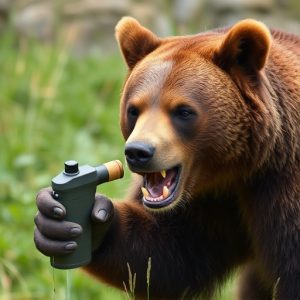Bear Spray Testing & Safety: Protecting Yourself from Grizzly Charges
Understanding grizzly bear behavior is key to safety in their territory. Combining calmness, appeara…….
Understanding grizzly bear behavior is key to safety in their territory. Combining calmness, appearance manipulation, and slow retreat with regular, controlled bear spray testing under the Bear Spray Testing Safety Guidelines can deter threats without harm. Bear spray, a specialized pepper spray effective against aggressive bears, requires proper usage knowledge and regular equipment testing for optimal performance. Adhering to safety guidelines during practice sessions, maintaining distance, wearing protective gear, and simulating bear charges is crucial. Combining bear spray with outdoor skills, understanding bear behavior, and minimizing attraction through secure food storage and scent management enhances safety in bear country.
In the vast wilderness, encountering a charging grizzly bear can be a terrifying reality. Understanding bear behavior and employing effective defense mechanisms are crucial for safety. This article explores strategic measures to defend against aggressive bears, focusing on the pivotal role of bear spray. We delve into its functionality, provide essential testing guidelines, and offer additional wilderness safety practices to ensure a secure outdoor experience. By equipping yourself with these insights, you’ll be better prepared to navigate potential encounters.
- Understanding Grizzly Bear Behavior and Their Charging Patterns
- What is Bear Spray and How Does it Work?
- Safety Guidelines for Testing and Using Bear Spray Effectively
- Additional Wilderness Safety Measures Beyond Bear Spray
Understanding Grizzly Bear Behavior and Their Charging Patterns
Grizzly bears are powerful animals with a reputation for aggression, but understanding their behavior is key to staying safe in their territory. When encountering a grizzly, recognizing their charging patterns can be life-saving. These bears often charge when they feel threatened or surprised, and their primary goal is usually to assess the situation and determine if you pose a danger. By remaining calm, making yourself appear larger by raising your arms or jacket, and slowly backing away, you can often defuse the potential threat without causing harm.
Regularly testing bear spray under controlled conditions following safety guidelines is crucial. Bear spray, when used correctly, can deter a charging grizzly bear by irritating its eyes and respiratory system. However, proper technique and familiarity with local regulations regarding bear spray usage are essential to ensure effectiveness and personal safety during encounters.
What is Bear Spray and How Does it Work?
Bear spray, also known as bear repellent, is a crucial tool for anyone venturing into bear country. It’s a specialized pepper spray designed to protect against aggressive bears, particularly grizzlies. The primary active ingredient in most bear sprays is capsaicin, derived from chili peppers. When sprayed, it irritates the eyes, nose, and respiratory system of the bear, causing it to turn away and retreat. This provides a vital window of safety for individuals or groups to escape or seek shelter.
The effectiveness of bear spray relies on proper usage and understanding the Bear Spray Testing Safety Guidelines. It’s essential to know that bear spray is not a guarantee of protection; it should be used as a last resort when a bear charges. Users must follow safety protocols, such as carrying the spray in an easily accessible area, knowing how to activate it, and being aware of its range and duration. Regular testing and updating of spray equipment are also recommended to ensure optimal performance when needed.
Safety Guidelines for Testing and Using Bear Spray Effectively
When it comes to testing and using bear spray for safety against charging grizzlies, adhering to specific guidelines is paramount. Always conduct practice sessions in a controlled environment, far from any wildlife or people. Familiarize yourself with the spray’s nozzle, range, and activation mechanism before use. Ensure you are within recommended distances, typically 20-30 feet (6-10 meters), when testing. Practice aim and technique by mimicking a bear charge, focusing on the bear’s face and eyes, which are sensitive areas.
During testing, wear protective gear like gloves and goggles to minimize potential injuries from spray mist. Use a training aid or target to simulate a bear and maintain a safe distance. Never test bear spray in an actual wilderness setting or near wildlife; this can be dangerous and disruptive to natural habitats. Regularly inspect the spray’s expiration date and ensure it is stored properly, as per manufacturer instructions, to maintain its effectiveness.
Additional Wilderness Safety Measures Beyond Bear Spray
In addition to carrying bear spray, one of the most effective wilderness safety measures against charging grizzly bears is acquiring robust outdoor skills and knowledge. Understanding bear behavior, habitat patterns, and natural deterrents can significantly enhance your safety in bear country. Always stay alert, make noise while hiking to avoid stealth, and travel in groups for increased visibility.
Regularly testing and understanding the Bear Spray Testing Safety Guidelines is crucial. This includes practicing proper usage techniques, knowing the spray range and effectiveness, and ensuring it’s accessible during emergencies. Additionally, keeping food securely stored and avoiding scent trails can reduce the likelihood of attracting bears. Remember, knowledge and prevention are key to navigating bear country safely.
When venturing into bear country, prioritizing safety is paramount. While understanding grizzly bear behavior and employing additional wilderness safety measures are crucial, bear spray testing and usage remain essential tools for protection. Adhering to strict safety guidelines ensures its effectiveness in fending off charges from these powerful animals. Remember that proper preparation and knowledge can make all the difference in navigating potential encounters safely.


